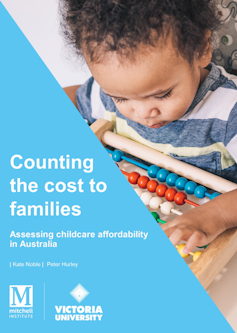Nearly 40% of Australian families can't 'afford' childcare
- Written by Peter Hurley, Policy Fellow, Mitchell Institute, Victoria University
Childcare is unaffordable for more than 385,000 Australian families, a new report from Victoria University’s Mitchell Institute shows.
The Counting the cost to families: assessing childcare affordability in Australia report uses an international benchmark of no more than 7% of disposable income spent on childcare to determine childcare affordability for families.
 Mitchell Institute report into costs of childcare.
Mitchell Institute report into costs of childcare.
We found nearly 40% of families using childcare use more than 7% of their household income on childcare.
We also found about 83% of families who use childcare spend more on childcare than on utilities or clothing. About 70% spend more on childcare than transport, and over 30% spend more on childcare than on groceries.
Our report also models the impact of the Australian government’s recent childcare subsidy announcement, due to take effect in July 2022. These changes will help families with two or more children under the age of six in childcare. But they still leave childcare unaffordable for about 336,000 families.
How do we measure childcare costs to families?
A lot of the discussion on childcare affordability focuses on per-hour costs and anecdotal evidence based on individual families’ circumstances. These are important, but can be hard to relate to for many families.
The Australian government also provides greater levels of subsidies to families who earn less. This means how much a family earns can substantially affect total childcare costs.
Read more: We need a new childcare system that encourages women to work, not punishes them for it
A better way to understand childcare costs is to explore its impact on the family budget.
To do this, we used data from the Household Income and Labour Dynamics in Australia (HILDA) survey. The survey collects detailed data on spending from over 7,000 households every year.
The figure below uses this HILDA data and compares the cost of childcare to other common household expenses.
What is affordable childcare?
Australia does not have an accepted way to measure childcare affordability.
But we do have affordability measures for other common household expenses. Housing stress for lower-income households, for example, is defined as a lower-income household spending more than 30% of gross income on accommodation.
The US Department of Health and Human Services has set a childcare “affordability threshold” for low to middle income families of 7% of take-home income. If families are spending more than 7%, the department considers childcare “unaffordable”.
The Biden administration has included the 7% affordability threshold in its childcare package worth US$225 billion over ten years. In the proposal, families earning 1.5 times the state median income will pay no more than 7% of their take home pay on childcare. For families earning 75% or less of the state median income, childcare will be free.
The figure below uses this 7% threshold to explore childcare affordability in Australia. It shows annual childcare costs as a proportion of family take home pay. Households exceeding the 7% threshold are in red.
This figure suggests about 386,000 Australian households, or about 39% of families using childcare, pay more than 7% of their household income on childcare expenses.
Because childcare costs vary by how much a family earns, it is also important to explore out of pocket costs by household income. The figure below shows out of pocket expenses as a proportion of take-home pay by different income groups.
This figure shows childcare affordability is an issue for many families, regardless of how much they earn. However, those on lower incomes have some of the highest rates of unaffordable childcare.
For instance, more than 33% of families who earn under A$70,000 per year spend 7-15% of their household income on childcare. And 15% of this group spend more than 15% on childcare.
This is compared to 8% of families earning more than A$200,000 spending over 15% on childcare.
Do the recent changes make childcare more affordable?
Childcare costs can multiply when families have more than one child in care.
The federal government’s recently announced changes aim to help families with multiple children in childcare. Under the proposal, the subsidy families receive for second and subsequent children will increase by up to 30 percentage points (capped at 95%).
This means families eligible for a 60% subsidy would now be eligible for a 90% subsidy on their second child if both children are aged under six.
The changes will also help families with a combined income of more than A$189,390, by removing the subsidy cap that restricts them to a maximum of A$10,560 per child a year.
The government says the new measures will impact 250,000 families when it is introduced in June 2022. But the federal budget estimates about 1.3 million families will use childcare in 2022-23. This means childcare affordability will not improve for about 1 million families.
Read more: An extra $1.7 billion for child care will help some. It won't improve affordability for most
We modelled the impact of the changes and applied the new subsidy rates to family childcare expenses reported in the HILDA survey.
We found, under the proposal, about 50,000 families would move below the 7% affordability threshold. This means about 336,000 families would remain with unaffordable childcare.
Unaffordable childcare often results in parents – usually women – deciding not to work, or working fewer hours than they would like.
Recent reports show increasing childcare affordability will improve workforce participation. It will also mean more children can receive the developmental benefits of formal early learning.
Authors: Peter Hurley, Policy Fellow, Mitchell Institute, Victoria University
Read more https://theconversation.com/nearly-40-of-australian-families-cant-afford-childcare-163497





